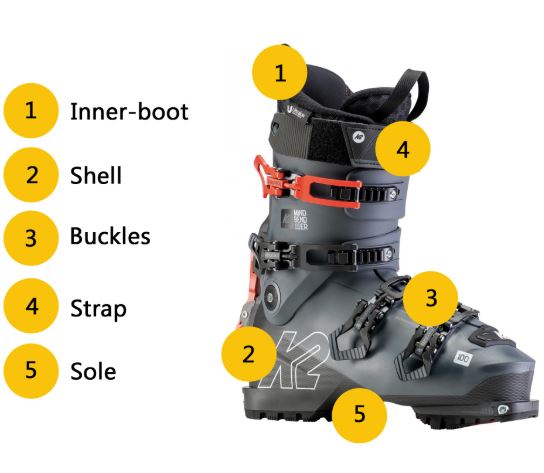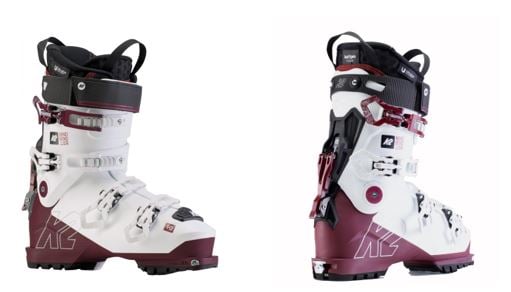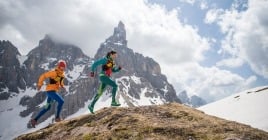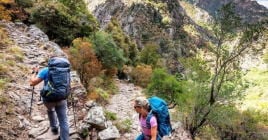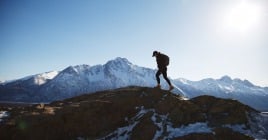ALL ABOUT SKI BOOTS
Its construction
- Bootie : the inner part of the ski boot which is made of foam, should provide you with optimal comfort because it is the part directly in contact with your foot, ankle, shin and calf.
- Thermoformable or not: Today, booties can be thermoformable, which consists in heating them (by professionals) so that they take the shape of your foot. In this case, the shoe is perfectly adapted to your morphology. This concept is nowadays more and more present on the market.
- To be put on or laced: according to your level and practice, the slipper can be presented in two forms. Most of the time, you don't need to remove it from your shoe since it is easy to put on and doesn't need any special adjustment; in competition, the shoe is laced, which means you have to remove it from the shell to put it on. Once the shoe is on your foot, you have to tighten the laces to your liking and then put the shell on. The adjustment will therefore be maximal and will allow an unequalled precision.
- Shell: the shell represents the rigid part of the shoe. Even if there are different models, the characteristics are the same (flex, width and length). The best known today, is the wallet shell, which comes with two main parts: the collar which is the upper part to tighten the calf and the shin, then the hoof which is the lower part surrounding your foot, for a full support.
- Thermoformable or not: The shells can also be thermoformable, which consists in heating them (by professionals) so that they take the shape of your foot. This notion is often used by competitors who have "deformations" of the foot, linked to daily practice.
- Width of the toe box: to meet all demands and morphologies, there are different shell widths at the toe level. Expressed as "last", it can extend from 92mm to 104mm. Although the width must be adjusted to hold your foot precisely, it is important to note that your toes must be able to move freely in your ski boot. It's up to you to choose what suits you best, for a great day on the skis.
- Buckle: more often called "hooks", they allow you to tighten your ski boot according to your desires/needs. The tighter your foot is, the more it will be maintained and the more the ski will react to your movements. Often they are placed like this: 2 on the hoof and 2 on the collar. The tightening is then complete and precise. Note that the buckle is different according to the practices. In the majority of cases, you have an additional "strap" at the top of the boot, which allows you to adjust the support of your leg more precisely, especially during flexions/extensions. It is up to you to tighten it tightly or not, depending on your desire in terms of comfort and/or reactivity.
- Sole: the sole is the lower part of the shoe, located under the hoof. This part is in contact with the ground when you walk but also with your ski when you put on your boots.
- Classic or Gripwalk : The sole is mostly classic on all ski boots, i.e. flat, made with materials identical to the hoof and collar. But since a few years, the notion of "gripwalk" is more and more present. This new technology allows you to walk more easily and naturally thanks to a slightly rounded shape but also to not slip when you arrive on less stable terrain, thanks to a better grip.
- Ski bindings adapted to the Gripwalk: As mentioned before, the Gripwalk is gradually taking up space on the market, which requires an adjustment of the ski bindings. Indeed, not being a "classic" sole, it does not fit on all bindings since it is slightly larger. Therefore, if you opt for this type of sole, make sure that your bindings are compatible with the Gripwalk system. Don't panic, most models are!
- Flex : The flex is the stiffness index of your ski boot (between the collar and the shoe). The higher it is, the more difficult it will be to bend it and flex your legs. But the higher it is, the more your boot will be reactive to your movements and therefore efficient. You have understood it, a high flex is reserved for a good level of skiing. Conversely, a low flex is ideal for beginners because the boot will be easy to bend and will allow you to adopt more easily, the attitude of a skier. Be careful that this one is also selected according to the skier's morphology.
- Possible option: Ski/walk system at the back of your calf, which is often present on Freerando boots and systematically present on ski touring boots. The person who practices Freerando is a skier who likes to have a ratio of 30% ascents and 70% descents during his days. This system plays on the rigidity of the boot (between the collar and the hoof), so it makes it easier to walk when you go up and to have real ski boots when you go down.
THE CRITERIA FOR CHOOSING THE RIGHT PAIR OF SKI BOOTS
GENDER
As with all products on the market, you can choose between a pair of men's ski boots and a pair of women's ski boots. Your gender is therefore a determining factor in the choice of your pair of boots. Note that women's models are often refined to the female morphology, i.e. thinner, for a better fit.
You will find all pairs of women's alpine ski boots, men's alpine ski boots and children's alpine ski boots on Alpinstore, with brands such as Rossignol, Lange, Dalbello, K2 , Fischer and Tecnica.
Some visuals of women shoes :
THE PRACTICE
As explained previously, practice is also a determining factor in the choice of your pair of ski boots since the technical characteristics can be different. Although the construction remains similar, the difference will often be in the stiffness and the buckle :
- Piste / all mountain : if you are a skier/skier of piste and/or all mountain, choose +/- rigid ski boots according to your level (see table below). Here, the rigidity otherwise known as "flex" is essential because it will make your equipment reactive to your movements, whatever the terrain you are skiing on.
- Freeride/Freerando : if you are a Freerando skier then choose ski boots with the "ski/walk" option. As described before, it is important to have this technology on your boots, to make the ascent easier and to give you a maximum of pleasure during the descent. There are two models of boots: classic boot with 3 hooks for a good compromise between weight, stability and price; boot with 4 hooks which is close to an alpine ski boot for a good compromise between ascent and descent.
|
FREERANDO PRACTICE |
NUMBER OF HOOKS |
|
30% up / 40% downhill |
3 or 4 hooks |
|
40% up / 60% downhill |
4 hooks |
|
80% up / 20% downhill |
All type of ski boots |
- Freestyle : if you are a freestyler at heart, opt for ski boots with a relatively straight collar so that you can perform all possible and unimaginable tricks on the modules. Freestyle boots are often equipped with cushioning zones under the foot and their flex is usually around 110
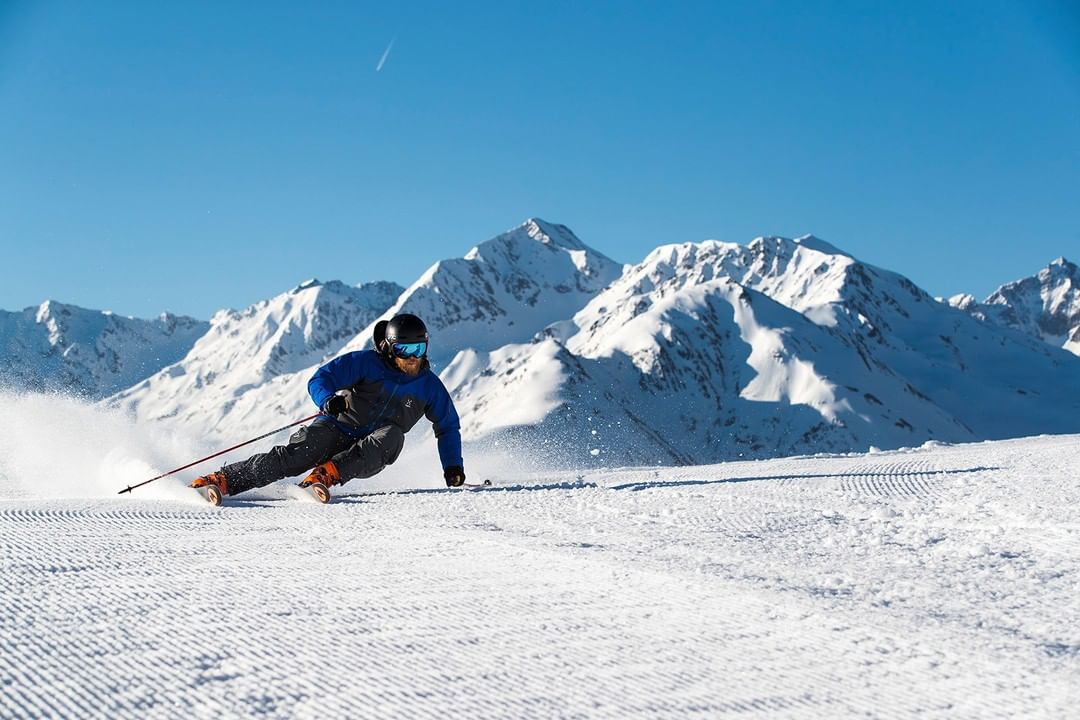
THE LEVEL
Of course, these ranges are given as an indication since the choice of flex will also depend on your morphology. The higher the weight, the greater the flex should be. Note that a flex that is too rigid can limit the skier's progression.
|
|
Beginner |
Intermediate |
Confirmed |
Expert |
|
Woman |
50 to 70 |
80 to 90 |
90 to 110 |
Minimum 110 |
|
Man |
60 to 80 |
80 to 100 |
110 to 120 |
Minimum 120 |
FOOT WIDTH
These widths are given as an indication since the choice will be made on a width that corresponds not only to your morphology but also to your practice. If you are a good skier, choose a last a little thinner, to gain in precision and on the contrary, if you want comfort above all, choose a wider width.
- From 94 to 99mm : for thin feet
- From 100 to 102mm: for normal feet
- From 102 to 104mm: for wide feet
SHOE SIZE
Inscribed in "mondopoint", it corresponds to the length of your ski boot and more precisely, to the length of your foot in cm. You will find it either on the outside of the sole or on the heel. To select the right size of ski boots, put them on! When your legs are stretched, your toes should touch the tip of the boot. When you flex your legs, your heel moves back and allows you to stop touching the tip. Be careful, make sure that the heel does not rise when you walk and/or bend. If these three criteria are met, then you have found the right size for you.
- An advanced/expert skier should look for a pair of boots that fit his or her size for best performance.
- A recreational skier will look for a pair of boots that are half a meter above his or her shoe size to ensure comfort throughout the day.

